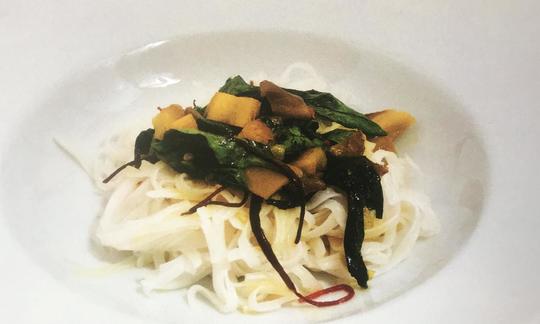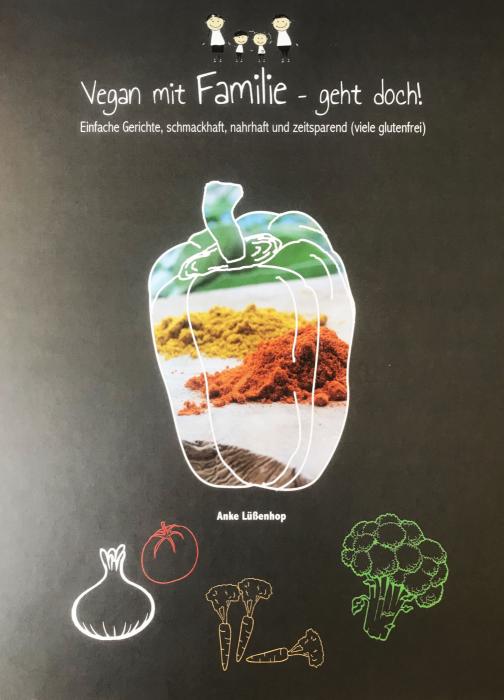Mushroom pan with chard, oyster mushrooms and tomatoes
vegan
Ingredients (for servings, )
| For the mushroom sauce | |
|---|---|
| 11 oz | Oyster mushrooms, raw (oyster mushrooms, organic?) |
| 1 clove | Garlic (organic?) (0.11 oz) |
| 1 | Onions, raw (organic?) (3.9 oz) |
| 1 tsp | Rapeseed oil, refined (organic?) (0.16 oz) |
| 1 dash | Turmeric (saffron root), ground, raw (organic?) (0.01 oz) |
| 1 dash | Table salt (table salt, raw?, organic?) (0.01 oz) |
| 1 dash | Black pepper (organic?, raw?) (0.00 oz) |
| 1 | Chili peppers, red, raw (organic?) (0.18 oz) |
| 8 ½ oz | Rice milk, rice drink (raw?, organic?) |
| 3 ½ oz | Vegetable broth without added salt (organic?) |
| 18 oz | Swiss chard / chard (raw, organic?) |
| 3 ½ oz | Cherry tomatoes, raw (cherry tomatoes, organic?) |
| For the rice noodles | |
| 11 oz | Rice noodles (organic?) |
Equipment
- skillet (frying pan)
- stove
- saucepan
- sieve
Type of preparation
- cook
- sweat
- strain
- bring to a boil
- remove the skin
Preparation
Prepare mushroom sauce
Clean the oyster mushrooms, peel the garlic and onions, cut the onions into small cubes.Sauté the mushrooms and onions in oil until translucent and press in the garlic cloves to warm them briefly.
The original recipe uses olive oil instead of rapeseed oil (see tips).
The garlic must not turn brown, otherwise it will taste bitter.
Now add the oyster mushrooms to the onions, season everything with turmeric, salt and pepper, chop the chili pepper and add it to the mushrooms.
Now all that's missing is the rice milk. Add this to the mushrooms along with the broth and bring everything to the boil briefly.
In the original recipe, the author uses regular vegetable stock. We have deliberately replaced this with extra low-salt vegetable stock to reduce salt (see tips).
If you want the sauce to be a little creamier, you can add carob flour to thicken it.
In the meantime, wash the chard and shake it dry. Now quarter the tomatoes.
The original recipe uses cocktail tomatoes, which are slightly larger than the cherry tomatoes we have specified.
Cook rice noodles and prepare mushroom sauce
Boil water for the rice noodles and place them in lightly salted water for about 3-4 minutes (depending on the instructions on the packet).When the rice noodles have been drained, add the chard and tomatoes to the sauce. Both should only be heated briefly, not boiled.
serving
Now arrange the rice noodles in portions with the mushroom sauce.
|
Nutritional Information per person
Convert per 100g
|
2000 kcal | |
|---|---|---|
| Energy | 386 kcal | 19.3% |
| Fat/Lipids | 3.2 g | 4.5% |
| Saturated Fats | 0.63 g | 3.1% |
| Carbohydrates (inc.dietary fiber) | 77 g | 28.7% |
| Sugars | 7.2 g | 8.0% |
| Fiber | 6.1 g | 24.5% |
| Protein/Albumin | 10 g | 20.0% |
| Cooking Salt (Na:493.8 mg) | 1'254 mg | 52.3% |
| Essential micronutrients with the highest proportions | per person | 2000 kcal | |
|---|---|---|---|
| Vit | Vitamin K | 1'043 µg | 1'391.0% |
| Sodium, Na | 494 mg | 62.0% | |
| Vit | Vitamin C (ascorbic acid) | 46 mg | 57.0% |
| Vit | Vitamin A, as RAE | 423 µg | 53.0% |
| Min | Copper, Cu | 0.52 mg | 52.0% |
| Min | Manganese, Mn | 1.0 mg | 52.0% |
| Elem | Potassium, K | 941 mg | 47.0% |
| Prot | Tryptophan (Trp, W) | 0.12 g | 46.0% |
| Prot | Threonine (Thr, T, irreversibly transaminated) | 0.39 g | 42.0% |
| Elem | Phosphorus, P | 287 mg | 41.0% |
Detailed Nutritional Information per Person for this Recipe
The majority of the nutritional information comes from the USDA (US Department of Agriculture). This means that the information for natural products is often incomplete or only given within broader categories, whereas in most cases products made from these have more complete information displayed.
If we take flaxseed, for example, the important essential amino acid ALA (omega-3) is only included in an overarching category whereas for flaxseed oil ALA is listed specifically. In time, we will be able to change this, but it will require a lot of work. An “i” appears behind ingredients that have been adjusted and an explanation appears when you hover over this symbol.
For Erb Muesli, the original calculations resulted in 48 % of the daily requirement of ALA — but with the correction, we see that the muesli actually covers >100 % of the necessary recommendation for the omega-3 fatty acid ALA. Our goal is to eventually be able to compare the nutritional value of our recipes with those that are used in conventional western lifestyles.
| Essential fatty acids | per person | 2000 kcal |
|---|---|---|
| Alpha-Linolenic acid; ALA; 18:3 omega-3 | 0.14 g | 7.0% |
| Linoleic acid; LA; 18:2 omega-6 | 0.67 g | 7.0% |
| Essential amino acids | per person | 2000 kcal |
|---|---|---|
| Tryptophan (Trp, W) | 0.12 g | 46.0% |
| Threonine (Thr, T, irreversibly transaminated) | 0.39 g | 42.0% |
| Isoleucine (Ile, I) | 0.47 g | 38.0% |
| Valin (Val, V) | 0.57 g | 35.0% |
| Phenylalanine (Phe, F) | 0.48 g | 31.0% |
| Leucine (Leu, L) | 0.68 g | 28.0% |
| Lysine (Lys, K, irreversibly transaminated) | 0.40 g | 22.0% |
| Methionine (Met, M) | 0.17 g | 18.0% |
| Vitamins | per person | 2000 kcal |
|---|---|---|
| Vitamin K | 1'043 µg | 1'391.0% |
| Vitamin C (ascorbic acid) | 46 mg | 57.0% |
| Vitamin A, as RAE | 423 µg | 53.0% |
| Vitamin B9, B11 (Folate, as the active form of folic acid) | 59 µg | 30.0% |
| Vitamin B2 (Riboflavin) | 0.41 mg | 29.0% |
| Vitamin B3 (Niacin) | 4.7 mg | 29.0% |
| Vitamin E, as a-TEs | 3.3 mg | 28.0% |
| Vitamin B7 (Biotin, ex vitamin H) | 13 µg | 27.0% |
| Vitamin B5 (Pantothenic acid) | 1.3 mg | 22.0% |
| Vitamin B6 (pyridoxine) | 0.30 mg | 21.0% |
| Vitamin B1 (Thiamine) | 0.20 mg | 18.0% |
| Vitamin D | 0.52 µg | 11.0% |
| Essential macroelements (macronutrients) | per person | 2000 kcal |
|---|---|---|
| Sodium, Na | 494 mg | 62.0% |
| Potassium, K | 941 mg | 47.0% |
| Phosphorus, P | 287 mg | 41.0% |
| Magnesium, Mg | 133 mg | 35.0% |
| Calcium, Ca | 94 mg | 12.0% |
| Essential trace elements (micronutrients) | per person | 2000 kcal |
|---|---|---|
| Copper, Cu | 0.52 mg | 52.0% |
| Manganese, Mn | 1.0 mg | 52.0% |
| Iron, Fe | 4.0 mg | 29.0% |
| Selenium, Se | 15 µg | 27.0% |
| Zinc, Zn | 1.7 mg | 17.0% |
| Iod, I (Jod, J) | 3.9 µg | 3.0% |
| Fluorine, F | 1.3 µg | < 0.1% |
Vegan with family – it's possible! – Simple dishes that are tasty, nutritious, and time-saving. The recipes are designed for quick and easy preparation.
Since this book is written in German, a description is omitted here. If you are interested, please switch to German in the menu.
The mushroom pan with chard, oyster mushrooms and tomatoes is easy to make, delicious and quick to prepare.
Nutrient profile : According to GDA guidelines, one portion of this recipe covers more than ten times the average daily requirement of vitamin K (mainly thanks to the chard) and a good 50% of that of vitamin C, copper, manganese and vitamin A. The ratio of omega-6 to omega-3 fatty acids is 5:1, which is exactly the recommended maximum ratio.
Swiss chard: Both the stems and the leaves of Swiss chard are edible. It tastes like spinach, but is more intense and bitter. Swiss chard contains a lot of vitamin K, but also vitamin C, vitamin A and vitamin E, as well as sodium, magnesium, potassium and iron. Like spinach, Swiss chard has a high oxalic acid content.
Oyster mushroom: The oyster mushroom is one of the most popular edible mushrooms. Its flesh smells pleasant and the raw flesh has a soft consistency.
Rice milk: Rice milk, also called rice drink, is a cereal milk that consists mainly of rice and water. It is lactose-free and easy to prepare yourself (see "Alternative preparation").
Rice noodles: The long, flat rice noodles are made from rice flour. Sometimes they consist only of rice starch, or tapioca flour or corn starch is added to make them appear more transparent. Since rice noodles are made from rice flour or rice starch, their health value is comparable to pasta made from white wheat flour. One positive difference, however, is that they are gluten-free, provided this is clearly stated.
Turmeric: While fresh turmeric has a resinous, slightly burning taste, dried turmeric is milder, even slightly bitter, and is used primarily for its coloring power. Turmeric, which comes from South Asia, belongs to the ginger family. The rhizome is very similar to ginger, but has an intense yellow-orange color, which it owes to the curcumin. The rhizome stimulates digestion.
What do you have to pay attention to as a vegan?
You can find more information about the composition of this dish in the nutrient tables under the recipe preparation. Information on the optimal ratio of fatty acids and general information on common nutritional errors in vegan and raw diets can be found at the following link: Vegans often eat unhealthily. Avoidable nutritional errors.
Cold-pressed rapeseed oil is not suitable in this case, as cold-pressed oils can only be heated slightly, in the case of cold-pressed rapeseed oil up to a maximum of 120 °C, as otherwise harmful substances are created. See the following link ( cold-pressed rapeseed oil). But refined rapeseed oil should also be heated up to a maximum of 180 °C. Under no circumstances should it start to smoke, although decomposition will begin before that.
Prepare your own rice milk: You can find instructions on how to make your own rice milk here. Alternatively, you can also use almond milk, oat milk or soy milk.
Homemade vegetable broth: You can find your own recipes for vegetable broth at the following links:
Vegan vegetable stock: As an alternative to low-salt vegetable broth, you can also use a vegan vegetable stock. You can find a recipe under the following link: Vegan vegetable stock.
Depending on how concentrated it is, you will need to adjust the quantities accordingly.
King oyster mushroom: Instead of the oyster mushroom, you can use the closely related king oyster mushroom or a combination of both oyster mushrooms.
Spinach instead of chard: You can use spinach instead of chard, which doesn't taste quite as bitter. Children often prefer fresh spinach to frozen spinach, which turns into a green mush when heated.






